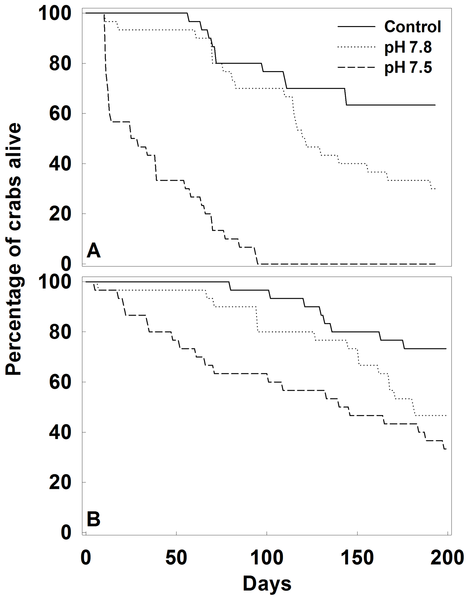Posted 4 Apr 2013 — Long WC, Swiney KM, Harris C, Page HN, Foy RJ (2013). PLoS ONE 8(4): e60959. doi:10.1371/journal.pone.0060959
Abstract
Ocean acidification, a decrease in the pH in marine waters associated with rising atmospheric CO2 levels, is a serious threat to marine ecosystems. In this paper, we determine the effects of long-term exposure to near-future levels of ocean acidification on the growth, condition, calcification, and survival of juvenile red king crabs, Paralithodes camtschaticus, and Tanner crabs, Chionoecetes bairdi. Juveniles were reared in individual containers for nearly 200 days in flowing control (pH 8.0), pH 7.8, and pH 7.5 seawater at ambient temperatures (range 4.4–11.9 °C). In both species, survival decreased with pH, with 100% mortality of red king crabs occurring after 95 days in pH 7.5 water. Though the morphology of neither species was affected by acidification, both species grew slower in acidified water. At the end of the experiment, calcium concentration was measured in each crab and the dry mass and condition index of each crab were determined. Ocean acidification did not affect the calcium content of red king crab but did decrease the condition index, while it had the opposite effect on Tanner crabs, decreasing calcium content but leaving the condition index unchanged. This suggests that red king crab may be able to maintain calcification rates, but at a high energetic cost. The decrease in survival and growth of each species is likely to have a serious negative effect on their populations in the absence of evolutionary adaptation or acclimatization over the coming decades.
Citation: Long WC, Swiney KM, Harris C, Page HN, Foy RJ (2013) Effects of Ocean Acidification on Juvenile Red King Crab (Paralithodes camtschaticus) and Tanner Crab (Chionoecetes bairdi) Growth, Condition, Calcification, and Survival. PLoS ONE 8(4): e60959. doi:10.1371/journal.pone.0060959
Editor: Sam Dupont, University of Gothenburg, Sweden
Received: September 14, 2012; Accepted: March 4, 2013; Published: April 4, 2013
This is an open-access article, free of all copyright, and may be freely reproduced, distributed, transmitted, modified, built upon, or otherwise used by anyone for any lawful purpose. The work is made available under the Creative Commons CC0 public domain dedication.
Funding: Funding was supplied through the NOAA Ocean Acidification Program (http://www.oar.noaa.gov/oceans/ocean-acidification/index.html). HP was supported by a NOAA Hollings Fellowship (http://www.oesd.noaa.gov/scholarships/hollings.html), and CH by was supported by a Pollock Conservation Cooperative Fund Award from Alaska Pacific University (http://marine.alaskapacific.edu/marine/announcement.html). The funders had no role in study design, data collection and analysis, decision to publish, or preparation of the manuscript.
Access this article on PLoS ONE
